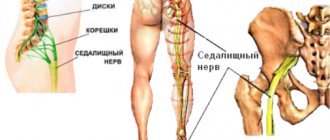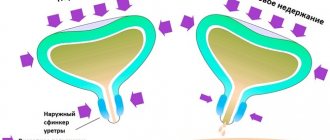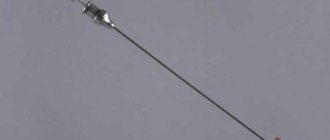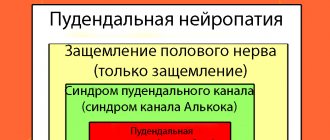We specialize in the treatment of chronic pelvic pain. A noticeable improvement is usually possible within 2-4 weeks of treatment.
Treatment is carried out by a neurologist-immunologist or rheumatologist. If necessary, we will involve a urologist or gynecologist in treatment.
Treatment of interventional pain
Typically, under ultrasound guidance, your doctor will insert a small needle along the course of the pudendal nerve and inject a small amount of local anesthetic. In the case of true pudendal neuralgia, pain relief will be immediate and dramatic. Trigger point injections. This procedure involves using a thin needle to release small contractures in local muscles called trigger points. These trigger points can cause pain in the pelvis and contract around the pudendal nerve, essentially strangling it, causing the nerve to become painful.
The average duration of treatment is 3 months
(You take your own medications.)
The average budget for treatment is 15 thousand rubles. The expected result is complete absence of pain.
Exercise technique
How to understand exactly where the pelvic floor muscles are located?
Remember those times when you really wanted to go to the toilet in a small way and squeeze your muscles as if you were trying to hold back urination. The muscles you squeezed are the “Kegel muscles.” They are the ones who need to be trained. Before starting a set of Kegel exercises, be sure to go to the toilet! Your bladder should be empty. The exercises can be practiced in any position convenient for you - lying, sitting or standing. If you like to do exercises lying down, then place your arms along your body and raise your knees slightly. Make sure your neck is not tense.
The basic movement of any Kegel exercise is squeezing. Carefully ensure that the muscles of the thighs, buttocks and abdominal cavity do not tense during exercises, otherwise you will not achieve any significant results. Never hold your breath while doing exercises. Breathe evenly, deeply and calmly.
Some women squeeze their intimate muscles while urinating, because they think that such actions can be compared to one of the Kegel exercises. Never do this, because such “training” not only does not strengthen the pelvic floor muscles, but also contributes to their weakening.
To achieve maximum results, perform the exercises 3 or 4 times a day. Each approach should contain no less than 5 and no more than 40–50 repetitions. Experts do not recommend dramatically increasing the number of repetitions. If the day before yesterday you did 20 repetitions, today you did 20, then under no circumstances do 40 repetitions tomorrow!
Many women who practice Kegel exercises note that results can be felt after 5 to 6 weeks of regular exercise.
Any physical activity should be approached with caution. Consult your doctor in advance about possible contraindications. If they are absent, then regularly strengthening the pelvic floor muscles will benefit women's health. A sedentary lifestyle, age-related changes, childbirth and other factors relax the muscles of the perineal muscles. Indications for starting exercises are as follows:
- pregnancy planning. Prepared muscles will more easily withstand upcoming loads and reduce the risk of complications;
- pregnancy. Strengthening the muscles of the vagina and perineum will facilitate and speed up the birth process;
- postpartum period. Muscles stretched from childbirth increase the risk of pelvic organ prolapse. Gymnastics will help you gain tone in a couple of months;
- age over 30. Changes in the body affect all organs. Simple exercises will help you maintain youth and health longer and improve marital relationships;
- detected pelvic organ prolapse. The doctor will prescribe treatment and give lifestyle recommendations, including exercises aimed at preventing prolapse;
- urinary and fecal incontinence. Complex treatment prescribed by a doctor is supplemented with special exercises;
- stagnation. During inflammatory processes, you can engage in physical exercise only on the recommendation of a doctor. Exercise will improve blood circulation and help get rid of pathologies.
Other indications for strengthening the pelvic floor muscles of women relate to anorgasmia, frigidity, decreased libido and other psychosexual disorders.
In each case, the attending physician makes a decision on an individual basis, determining whether it is possible to train the muscles of the perineum in the presence of certain health problems. Contraindications are:
- acute form of inflammation of the pelvic organs. If you have adnexitis, cystitis, or endometriosis, you must first undergo treatment;
- neoplasms. Regardless of the nature of the tumor, gymnastics is prohibited;
- condition after surgery, tendency to hemorrhoidal, uterine bleeding;
- infectious diseases accompanied by intoxication and fever;
- cervical erosion;
- venous insufficiency;
- increased uterine tone, a history of miscarriages, gestosis in a pregnant woman.
Since time immemorial, women from all countries have taken care of their intimate muscles and used various techniques and techniques to strengthen them. These techniques are found in ancient Taoist and tantric practices (Sahajoli), and in yoga, and in the Kama Sutra. Nowadays, in Europe and America, the exercise system and simulator developed by the American gynecologist and doctor of medicine Arnold Kegel is extremely popular. Kegel suggested training the pubococcygeus muscle to improve women's health.
In Russia, when talking about intimate gymnastics, the terms “VUMbuilding” and “Imbuilding” are often used. Behind these two systems are the names of V. Muranivsky and Yu. Kornev. Back in Soviet times, Muranivsky, together with the country's leading gynecologists, developed a unique system of training the pelvic muscles, as well as a new improved simulator for these purposes.
His system is usually called “VUM building” (VUM - Vaginally Controlled Muscles, building (English) - to build). When developing it, he turned to both the Kegel system and various Eastern teachings and practices. “Imbuilding” (IM (abbr.) - intimate muscles) is a term used to refer to the system developed by Kornev, although the term itself was originally introduced by the same Muranivsky. Kornev improved his system and made some adjustments. Imbuilding is a training technique.
In addition to a set of exercises to strengthen intimate muscles, it is also very useful to use special exercise equipment and devices.
Exercise machine "Egg"
Made from medical polymer or jade. It was used to train intimate muscles in ancient China and India.
Can be used from the first weeks of training. In addition to various active exercises, you can and should simply wear it in the vagina during the day.
Check at home to see if your egg falls out when you urinate, so you don't lose an egg later in a public toilet. If an egg falls out, remove it every time you go to the toilet. Carrying an egg helps you remember to work your pelvic floor muscles.
Exercises with eggs are used to develop the muscles of the entrance, walls and vaults of the vagina.
Be careful! Jade eggs brought from China are most often made from cheap jadeite rather than jade, and do not have the healing properties of the latter.
Vaginal balls
They are two balls connected by a thread. They were invented in ancient Tibet.
Train the lower part of the vaginal canal. Just like an egg, they are suitable for weak muscles from the first days of training.
When purchasing them, keep in mind that the smaller the balls, the more work your muscles will do. You can only train in them while standing. If suddenly the balls don’t come out, you just need to lie down and relax, they will roll out on their own.
It helps diagnose the condition of your muscles and strengthen them. It is a rod with a ball at one end and a laser pointer at the other.
Suitable for beginners with untrained muscles.
Kegel exercisers
These are simulators with mechanical and pneumatic feedback. They are a chamber that is inserted into the vagina and a pressure gauge attached to it (a device that measures the pressure inside the chamber).
When the muscles are compressed, the pressure changes, which is displayed on the pressure gauge.
You can proceed to it only with already strengthened muscles after training with an egg and/or a laser simulator.
The exercises do not contain exhausting workouts. Their main goal is regular tension, which will provide muscles and tendons with increased blood flow and make them more elastic.
The first exercise involves tensing your Kegel muscles for a short period of time. To do this, you need to make an effort, the same as if you had to stop urinating. Having held the tension, you need to maintain it for 5 seconds, then relax and breathe deeply. A complete one-time complex is at least 5 approaches; if desired, you can increase their number.
The next exercise consists of five minutes of alternating tension of the pelvic muscles. To do this, you need to concentrate on the lower part of the body, systematically, moving your attention through your own body, try to strain various Kegel groups. You can start with short periods of concentration, the duration of which is 5-10 seconds. Gradually, you can bring the technique to the point where a person will simply change Kegel groups for the entire five minutes, without a break.
There will be nothing new further. Only in-depth old. Having concentrated, you need to strain the muscles located at the very bottom, gradually transferring the load to the upper layers. To perform this action, you will need some experience with the previous exercise.
The final level of mastery of the Kegel technique is selective tension and the ability to feel individual muscle groups. When the practitioner begins to exercise any of the areas at will, she will begin to receive the greatest benefit from the training, and will significantly improve her sexual health. Regular exercise will increase blood flow to the genitals and the nerves will become more sensitive. Thanks to this, your sex life will become brighter.
If desired, you can use additional exercise equipment. This will increase the load on the muscles, which will lead to their rapid strengthening. However, not all doctors in the field of gynecology and obstetrics agree that this is beneficial. Strongly trained pelvic floor muscles prevent them from performing their functions, and they will also compress the vessels and nerves passing through them. But since no research has been conducted on this issue, everyone decides for themselves what to do.
The simplest exercise machine is weighted balls. Having placed them in the vagina, the woman needs to hold them inside while standing. Similar items can be purchased in specialized stores.
Also gaining popularity is the convenient “AirBee” accessory, which is placed in the vagina and creates pressure on its walls. The advantage of the device is the presence of 8 programs for different stages of strengthening. It can be connected to a smartphone.
Fun Toys Gballs2 App, as the name suggests, also has a connection to a smartphone and consists of two balls, the voltage of which can be changed.
About treatment
The initial goal of the treatment process is to remove or at least reduce pain. In this regard, an analgesic is used in most cases. Then you can use medications that are available in the form of gels and ointments. If there is a complex pinched nerve, then the use of various kinds of hormonal drugs is indicated, then the treatment will last a long time.
In addition to treatment with medications, physiotherapeutic methods are very actively used, which have proven themselves very well, such treatment is becoming more and more common. Traditional medicine treatment is also very popular; such remedies can really help a lot, but before using them you must definitely consult a doctor, otherwise the treatment may not end well. Such remedies often help reduce discomfort so effectively that even the use of antidepressants is not necessary. There are many such treatment options with folk remedies, it is worth talking about the most common:
- you just need to grate the horseradish and apply it to the affected area;
- take indoor geranium, apply its leaves where it hurts, then wrap everything in a bandage;
- squeeze out the black radish and rub its juice on the affected area;
- take lilac buds, dry them, crush them, mix with pork fat and use as a rub;
- mix fresh wormwood and olive oil to make a paste and apply it where it hurts.
The structure of the pelvic floor and vaginal muscles
It is necessary to say a few words about what the pelvic floor muscle is.
The pelvic floor muscles are like a two-layer hammock or, if well trained, like a trampoline on which the internal organs lie. These two layers are called the superficial and deep layers. Their main function is to maintain the internal organs of the pelvis and abdominal cavity in the correct location and prevent displacement.
It is very difficult to control the effort of thought on the surface layer, so in intimate gymnastics various simulators are used to train it.
The same applies to the upper part of the vagina, which is compressed not by the vaginal muscles, but by the increase in abdominal pressure created by the abs and abdominal diaphragm. Therefore, its strengthening is also achieved with the help of exercise machines and only after the pelvic muscles are already well strengthened.
The deep layer runs around the vagina and is attached to the pubis and pelvic bones. In fact, all the pelvic organs are located in its muscles. As a rule, all exercises controlled consciously (without simulators) are aimed specifically at training the deep layer. It includes the muscles that lift the anus, they also cover and compress the vagina from behind and from the sides.
From the above it follows that at the initial stage it is much more important to train the compression and retraction of the anus, rather than the vagina.
A woman’s vagina is a muscular organ, 8-10 cm long, located in the small pelvis from the entrance to the vagina to the cervix.
When training the pelvic floor muscles, you should also distinguish between the sections of the vagina: the first section of the vagina is its anterior part and the muscles of the external entrance, the second section is the muscles of the vaginal canal, located directly in front of the cervix, the third section is the muscles of the middle of the vaginal canal.
The pelvic floor supports all the abdominal organs, including the genitals. It consists of several muscle groups.
Functions of pelvic floor tissues:
- excretion of urine, bowel movements;
- closure of the middle part of the rectum, narrowing of the sphincter;
- keeping the genitals in place;
- participation in the control of intra-abdominal pressure;
- expulsion of the fetus from the mother's body during childbirth.
The edges of the pelvis are:
- lunar articulation;
- tip of the coccyx;
- sit bones.
All the pelvic muscles located in the pelvic floor are a collection of individual bundles that form a kind of plate that completely covers the exit. The pelvic area contains the genitourinary organs and the defecation system.
Muscle bundles can be divided into four main groups:
- ischiocavernosus;
- bulbous-spongy;
- anal-ring sphincter area;
- superficial transverse tissues.
Each of the listed groups performs its assigned tasks, depending on the type of movement or function being performed.
Tendon center
The tendon center is located in the very center of the perineum. With its help, the external muscles and fascia of the pelvic floor are attached to the bones. In this way, the entire system is supported. When viewed from above, the ligament pattern appears as a figure of eight suspended from the pelvic bones.
External muscles:
- Bublo-cavernous - surrounds the entrance to the vagina, attached with one edge to the tendon center and the other to the clitoris.
- Ishio-cavernousus – connects the ischium to the outer side of the clitoris.
- Transversus perinei superficialis - goes to the sides from the tendon center, joins the ischial tuberosities.
- Shincter ani extetnus - fibers that elevate the anus surround the sphincter.
These are the most important connections in the external pelvic floor muscle system.
The inner layer of muscles is also called the upper or genitourinary pelvic diaphragm. It consists of two bundles of fibers, the work of which is to lift the section of the rectum located on top of the anus. These are large muscles, the anatomy of which is a concave surface with a central part facing down.
Pelvic floor fascia
There are dense fascial fibers around the urethra in men and the vagina in women. Their anatomy is a striated structure that connects the exit of the genitals to the tendon-fascial region.
Pelvic floor nerves
The innervation scheme of the pelvic floor muscles includes three large groups of nerves: pudendal, hypogastric, and lumbar.
The fibers of the lumbar spine are a continuation of the lumbosacral nerve. Which in turn consists of the 12th thoracic and 4th lumbar.
The hypogastric plexus consists of a pair of large nerves and runs along the pelvic diaphragm and near the rectum.
The pudendal nerves depart from the last vertebrae of the coccyx, pass along the vagina and end on the clitoris. In addition, they have smaller branches.
Symptoms of pelvic neuralgia in a pregnant woman
Signs of pelvic neuralgia in expectant mothers do not have any special features. Usually these are chronic nagging pains or paroxysmal, burning sensations. In addition to soreness, there may be numbness or a crawling sensation. The pain may intensify with exertion or prolonged stay in the same position. This explains their intensification at night. Movement on the affected side may also cause discomfort. The variety of clinical symptoms may be explained by differences in the anatomical relationships of nerves and blood vessels.
Causes and symptoms of chronic pelvic pain
Likewise, sitting on hard surfaces is more comfortable. Another common symptom is a foreign body sensation in the vagina, perineum, or rectum, often described as a "golf ball" or "tennis ball" sensation. To describe this sensation, we coined the term "allotriesia" from the Greek allotri - and aesthesia. Defecation and urination can also be painful, leading to dysbiosis and urinary hesitancy. Urinary or fecal incontinence may develop from decreased sphincter tone if motor function is affected.
Indications and contraindications
Training is especially useful:
- Women planning a pregnancy and carrying a child. Exercises help prepare for the upcoming load, avoid vaginal ruptures and sprains.
- After childbirth. Gymnastics helps restore the muscles of the pelvic girdle and is effective in cases of organ prolapse. In 1–2 months you can tone your muscles.
- After 30 years. Exercises are needed for the prevention and elimination of deformities of the pelvic elements. Used to improve the quality of sexual intercourse.
- With diagnosed displacement. In this case, exercise therapy is prescribed by a doctor. The complex prevents further organ loss, helping to strengthen muscles.
- For fecal or urinary incontinence. Gymnastics is also therapeutic in nature and is discussed with a specialist. It is considered an important stage of therapy.
- People with circulatory disorders and congestive processes. Exercise gets your blood pumping and reduces the risk of developing tumors.
There are contraindications for charging:
- Acute stage of inflammatory diseases: endometriosis, cystitis, adnexitis.
- Benign and malignant tumors, recent removal of tumors.
- Complications of infections: fever, intoxication of the body.
- Rehabilitation after operations, fractures, endoprosthetics, the period of wearing bandages.
- Venous insufficiency, tendency to hemorrhoidal or uterine bleeding.
- Cervical erosion, arthrosis, aseptic necrosis, coxarthrosis.
Pathologies of the gastrointestinal tract
Adhesive disease
Injuries, inflammations, and intestinal surgeries are the most common causes of the formation of adhesions in the gastrointestinal tract.
Symptoms:
- pain in the abdomen, radiating to the lower back and pelvis, of a pulling nature;
- dyspepsia.
Diagnostics:
- tests;
- Ultrasound of the abdominal cavity;
- CT;
- laparoscopy.
Treatment:
- often - surgery to cut adhesions;
- conservative treatment: hypertensive enemas, anticholinesterase therapy, enzyme preparations, anti-inflammatory drugs.
Proctitis
Inflammatory disease of the rectum is characterized by such manifestations as pain in the perineum and lower back.
Other signs:
- burning, heaviness in the intestines;
- bloody, purulent discharge;
- low-grade fever;
- malaise;
- diarrhea, constipation;
- blood in stool.
Article on the topic: Detailed instructions for the use of capsaicin
Diagnostics:
- manual rectal examination;
- rectoscopy;
- biopsy;
- analysis and culture of stool for bacteria.
Treatment:
- diet;
- antibiotics;
- antispasmodics;
- antihistamines;
- cleansing and therapeutic enemas;
- sitz baths;
- tissue-regenerating drugs;
- glucocorticoids.
- during the period of remission - treatment in a sanatorium, physiotherapy, massage, exercise therapy.
Chronic colitis
Lesions of the colon of inflammatory-dystrophic etiology develop as a result of constant nutritional disturbances and the ingress of bacteria.
Symptoms:
- pain in the abdomen: below or on the side - dull or paroxysmal;
- flatulence;
- diarrhea, constipation;
- stool is mushy, mixed with mucus;
- constant pelvic pain;
- heartburn, belching, nausea;
- weight loss.
Diagnostics:
- blood and stool tests;
- colonoscopy.
Treatment:
- hospitalization;
- strict diet;
- enveloping, astringent agents;
- antispasmodics;
- anti-inflammatory;
- sorbents;
- physiotherapy;
- mud therapy.
Irritable bowel syndrome
The most common gastrointestinal disease , the causes of which are not precisely established, but it is almost always possible to get rid of its appearance.
Symptoms:
- pain of varying intensity anywhere in the abdomen, radiating to the pelvis;
- diarrhea, constipation;
- stool consistency is unstable;
- nausea, periodically - headache, flatulence, heartburn, vague back pain, fatigue.
Diagnostics:
- blood tests;
- stool analysis for Giardia cysts and worm eggs;
- EGDS;
- Ultrasound;
- colonoscopy.
Treatment:
- antidiarrheal or laxatives;
- probiotics;
- diet and nutrition;
- active lifestyle.
Appendicular-genital syndrome
Inflammation of the uterine appendages in parallel with appendicitis is observed in girls of puberty as a result of infection.
Symptoms:
- pain in the abdomen, in the navel area, more on the right;
- nausea, vomiting, diarrhea, lack of appetite;
- heat;
- blood pressure surges;
- rapid heartbeat;
- purulent discharge;
- headache and muscle pain, sweating;
- pain in the sacrum.
Diagnostics:
- lab tests;
- Ultrasound of the abdominal cavity, appendages and appendix;
- X-ray;
- ECG;
- hysterosalpingography.
Treatment:
- antibiotics;
- rectal suppositories;
- sulfonamides;
- vitamin therapy;
- absorbable drugs;
- physiotherapy;
- surgical treatment if signs of appendicitis predominate.
A set of Kegel exercises
The good thing about intimate gymnastics is that you can do it anywhere and anytime, without wasting money and time on trips to gyms.
Training can take a total of 15-20 minutes per day. The first noticeable results appear within a couple of months and last for several years.
First, we need to learn to tense the intimate muscles separately from the abs and buttocks and not hold our breath.
Next, we learn to retract and hold the anus, and at the same time breathe with the stomach, either inflating it or relaxing it.
We squeeze the muscles of the anus, try to pull them up and at the same time feel the vaginal muscles - when the anus is pulled in, they should also work.
We squeeze the anus to reduce the gap in the vagina from the sides and behind, and the tension of the vaginal muscles of the entrance narrows the vagina in front.
We alternately squeeze the muscles of the vagina and anus. This exercise will help you better feel the work of these muscles.
We strain the muscles of the anus and vagina at the same time and pull them upward as much as possible.
Another exercise is done while lying on your back. Legs are bent at the knees. Feet – shoulder width apart. The arms lie freely along the body. Raise the pelvis. At the same time, we tense the pelvic floor muscles, gluteal muscles and hips. We hold this position for 10 seconds and lower our pelvis to the floor. You can also do variations of this exercise with your feet raised on your toes, and, conversely, with your feet on your heels when lifting your pelvis up.
Take a comfortable position and contract your intimate muscles. After 5 - 10 seconds, relax your muscles.
For beginners, this exercise should be repeated 2-3 times a day. One approach should contain 10 – 12 repetitions. The number of repetitions can be gradually increased to 45–50 times in one approach.
For 5–7 seconds, contract the “Kegel muscles” at a rhythm that is comfortable for you, then take a break for 5–7 seconds and start over.
For women just starting to get acquainted with the Kegel exercises, experts advise doing 3 to 4 approaches per day. Each approach should have at least 10 repetitions. The duration of contraction of intimate muscles can be gradually increased to 10 - 12 seconds.
This exercise will help you make your intimate muscles more resilient and strong. It is practically no different from the second exercise. The only difference is that in 5–7 seconds you need to make as many contractions as possible. After the first set, rest for 5–7 seconds and repeat the compressions at a fast pace.
Find a comfortable position and think about how you feel when you ride up or down in an elevator. Now imagine that your intimate muscles are an elevator. As the elevator goes up, begin to tighten your pelvic floor muscles more and more until you reach the top floor.
Once you reach the top floor, send the elevator down. To do this, you need to smoothly and gradually relax your muscles. Make a short stop on each floor. Having reached the first floor, wait 1 - 2 seconds, and then send the elevator to the basement and completely relax your intimate muscles.
To perform this exercise, you need to use the muscles of not only the vagina, but also the anus. First contract the vaginal muscles and then the anal muscles. After 5 - 7 seconds, relax the muscles of the vagina, and then relax the muscles of the anus.
The duration of contraction of the muscles of the vagina and anus can be gradually increased to 15 - 20 seconds.
This exercise is very useful for expectant mothers. Be sure to empty your bowels before starting.
Take a comfortable position (sitting, lying down, on all fours, squatting), relax your body completely, then hold your breath for a few seconds and push as if you want to go to the toilet in a big way. This exercise can be combined with various breathing practices.
Find a comfortable position and slowly take a deep breath. Gradually begin to squeeze your intimate muscles as hard as you can. When you reach the limit and realize that it is no longer possible to squeeze your muscles even stronger, freeze in this position for 3–6 seconds. As you exhale deeply, gradually relax your Kegel muscles. Do 3 – 5 approaches.
When you take a deep breath or exhale, focus all your attention on the muscles. You should feel every intimate muscle. Thanks to this, the pelvic floor muscles will work more actively and efficiently.
After taking a comfortable position, take a deep breath and gradually squeeze your intimate muscles until you realize that you cannot squeeze them any further. Then exhale, but not slowly, as in the previous exercise, but sharply and quickly. As you exhale, sharply relax your Kegel muscles, as if you want to push all the air out of the vagina. Do 3 – 5 approaches.
This exercise is performed in a lying position. You need to lie on your back and bend your knees. While performing the exercise, you should not lift your shoulders and feet off the floor. Without squeezing your intimate muscles, try to raise your pelvis as high as possible.
Having raised your pelvis as high as possible, freeze in this position for 6–12 seconds, and then lower your pelvis and take the starting position. To achieve maximum results, you need to do 10–20 repetitions.
This exercise increases blood flow to the pelvis, due to which the internal organs and muscles are more actively saturated with oxygen. And the bridge that you will do by raising and lowering your pelvis will make your gluteal muscles stronger.
This exercise is performed standing. Place your feet shoulder-width apart and place your palms on your hips. You need to bend your knees slightly and move your hips first to the right and then to the left. Reaching the extreme right or left point, squeeze your intimate muscles as hard as possible. Relax your pelvic floor muscles as soon as you begin to move your hips in the other direction. Repeat 25 – 35 times.
A set of Kegel exercises has virtually no contraindications. But it should be avoided by women who have recently suffered a miscarriage, major surgery, or premature birth. Girls who have been diagnosed with malignant tumors should not practice the exercises.
Doctors say that exercise is completely safe for women's health. But if you experience pain or discomfort during exercise, then training should be stopped until you consult with a specialist and he allows you to resume them. It is also necessary to seek help from a gynecologist if you do not feel any changes for the better, although you have been practicing the exercises for 3 to 5 months.
We recommend: How long can it take to pump up abs for a man and a girl: a set of exercises
If you find an error, please highlight a piece of text and press Ctrl Enter.
Contact the clinic
If you have chronic pelvic pain syndrome or suspect it, we recommend that you first consult a neurologist.
The main mechanism causing pelvic pain in women is considered to be compression of the nerve in the anatomical structures through which they pass. This happens due to microcirculatory disorders that cause congestion of the vessels surrounding the nerve. Roughly speaking, the nerve is pinched by ligaments and tendons.
It is a severely painful and disabling neuropathic condition affecting both men and women, including dermatomas of the pudendal nerve. It has also been described as Alcock's canal syndrome, cyclist's syndrome, and pudendal nerve entrapment. However, Puendal Neuralgia remains relatively unknown. However, this syndrome if often is not recognized by most doctors, including pelvic pain doctors such as gynecologists, urologists and neurologists. Pudendal neuralgia is described as neuropathic pain along the distribution of the pudendal nerve.
Kegel exercises
To improve control over your actions, you can insert 1-2 of your fingers or another suitable object (pre-lubricated with Vaseline) into the vagina. It is advisable to perform each exercise five times a day.
Here are the main exercises of the system:
- We learn to compress and unclench the muscles of the perineum. We do this by holding each compression and each relaxation for a few seconds.
- Rapid (as possible) contraction and relaxation of the vaginal muscles. Do 25-30 contractions.
- Pushing out. Imagine that you need to push something out of the vagina using the muscles of the perineum. Keep the perineal muscles in this state for as long as possible.
Diagnostics
To make a diagnosis, you should consult a neurologist. Often patients, faced with pain in the pelvic organs, consult a gynecologist or urologist and, not finding pathology of the internal organs, let the disease take its course. This should not be done under any circumstances, because the pain will not go away without treatment.
To make a diagnosis, it is necessary to exclude organic pathologies of internal organs, so consultation with a gynecologist or urologist is mandatory.
To assess the condition of the nerve, it is necessary to perform an impulse conduction analysis. To rule out back diseases, you will need to do an X-ray and MRI of the lumbar region.
Examples of exercises with vaginal balls and eggs
Both the balls and eggs are inserted into the vagina very carefully and gradually. In this case, the loop from the balls remains outside. The starting position for all exercises is the rider's pose: legs shoulder-width apart and slightly bent at the knees, back and neck straight, hold your hands with your palms up in front of you.
We tighten the muscles of the uterus so that nothing can fall out of the vagina. Move the eggs or balls left and right, up and down. We train until we learn to easily manipulate the intimate muscles. You can do this for a few minutes a day.
Squeeze the first, second and third sections of the vagina alternately. Start by moving the balls or eggs slowly and gradually speed up.
Move the ball left and right using the second section of the vagina, then using the first. To master these exercises, actively use mental effort.
Wiggle. Hold an egg or ball alternately in both sections of the vagina and try to swing them in both directions.
Intramural structures
These neurons, together with their pathways, may constitute the metasympathetic portion of the autonomic nervous system. According to histologist Dogel, among intramural types of structures there are three types of cells. The first include long-axonal efferent elements of type I. These cells have large neurons with long dendrites and short axons. Equal-processed afferent nerve components are characterized by long dendrites and axons. And associative neurons connect cells of the first two types.
Peripheral system
The task of the nerves is to provide communication to the nerve centers of the spinal cord, brain and nerve structures. The elements of the system interact through connective tissue. Nerve centers are areas responsible for processing information. Almost all of the structures under consideration consist of both afferent and efferent fibers. A set of fibers, which is, in fact, a nerve, may contain not only structures protected by an electrically insulating myelin sheath. They also contain those that do not have such “covering”. In addition, the nerve fibers are separated by a layer of connective tissue. It is distinguished by looseness and fibrousness. This layer is called the endoneurium. It contains a small number of cells, the main part of which is collagen reticular fibers. This tissue contains small blood vessels. Some bundles of nerve fibers are surrounded by a layer of other connective tissue - the perineurium. Its components are sequentially located cells and collagen fibers. The capsule that envelops the entire nerve trunk (it is called the epineurium) is formed from connective tissue. It, in turn, is enriched with fibroblast cells, macrophages and fat components. It contains blood vessels with nerve endings.












